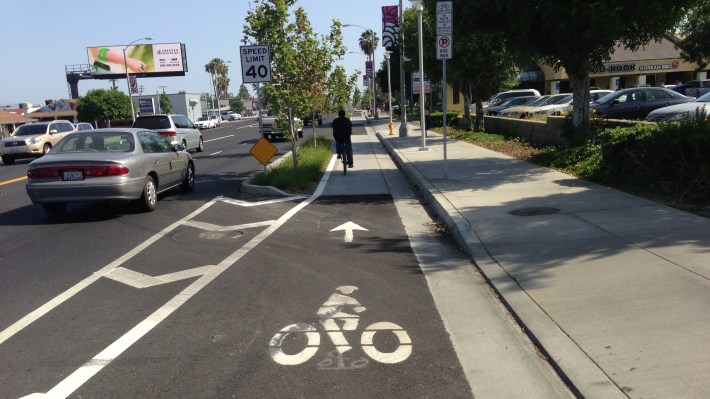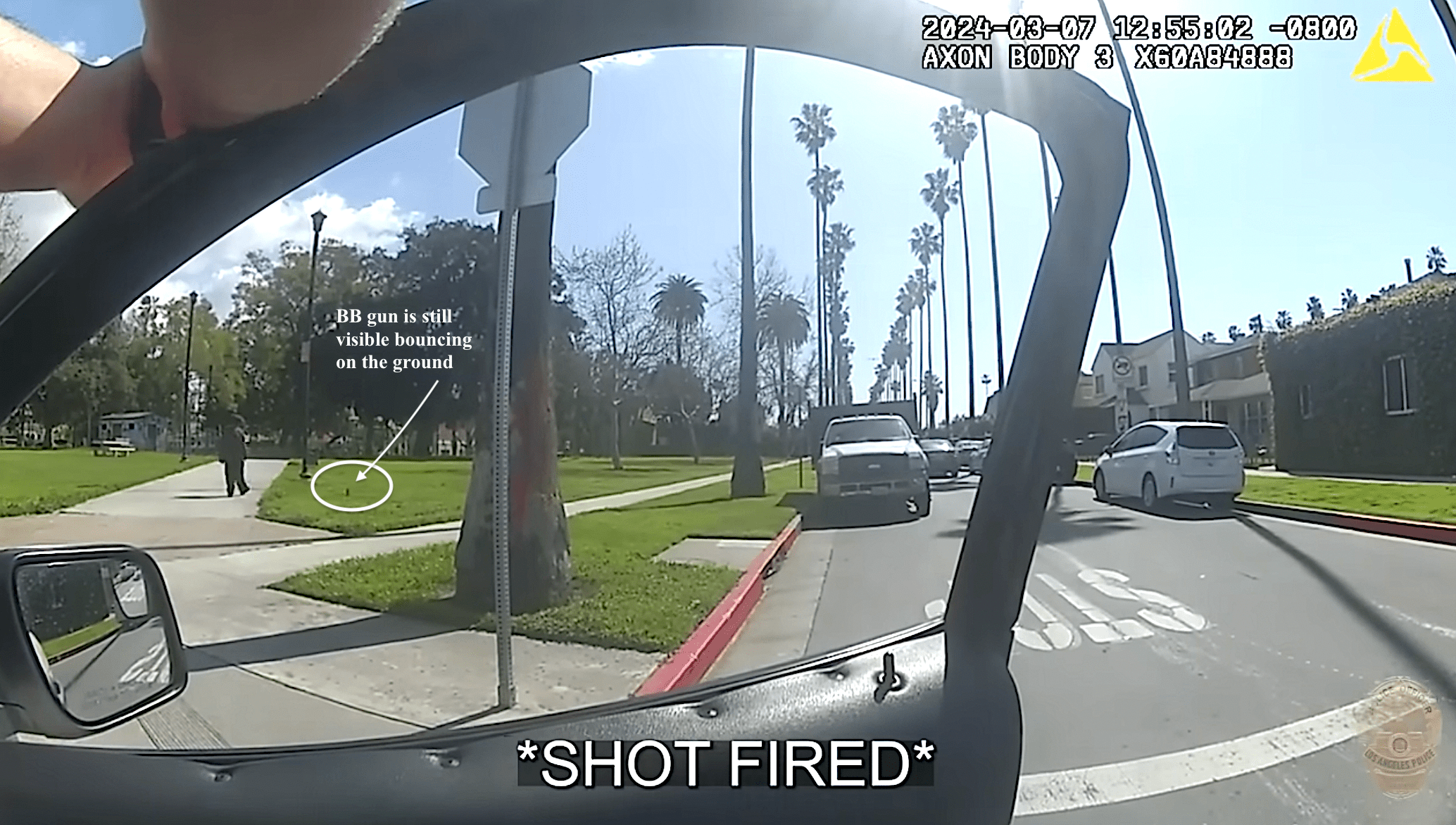Protected Bike Lanes Bill Passes CA Senate Transportation Committee
2:08 PM PDT on June 27, 2014
The "Protected Bikeways Act," A.B. 1193, passed the Senate Transportation and Housing Committee Thursday on a 10-0 vote, despite opposition from some quarters. The bill must still be approved by the full Senate and Governor Jerry Brown.

The proposed legislation, introduced by Assemblymember Phil Ting (D-San Francisco), would compel Caltrans to create guidelines for protected bike lanes, a type of facility that is not currently allowed under California law.
A second measure in the bill would give local jurisdictions — cities and counties — the freedom to follow Caltrans standards for bicycle infrastructure or to choose some other guidance. Currently all bicycle infrastructure in California must adhere to Caltrans standards, whether it's built on state highways or local streets. There are a few limited exceptions to this, generally through cumbersome experimental processes, but overall Caltrans' antiquated standards have limited implementation of infrastructure that has proven safe in other states and other countries.
“This comes down to an issue of local control,” said Ting. “Cities have control over every aspect of their streets except when it comes to bikes.”
Supporters at the hearing included representatives from Napa County, the city of San Jose, the San Francisco Municipal Transportation Agency, and Los Angeles Mayor Eric Garcetti's office.
The bill's proposal to remove Caltrans' oversight of bike facilities on local streets stirred up some controversy. The League of California Cities opposed the bill on the grounds that this provision could expose cities to litigation, removing design immunity provided by Caltrans engineering standards. This opposition came despite the bill's proposed wording that cities “may”--rather than “shall”--comply with Caltrans standards.
“I would think the League would be more interested in local control,” said Senator Richard Roth (D-Riverside).
“It's very interesting,” admitted Jennifer Whiting, representing the League. “Normally we would be arguing for that 'may.' But over the last few years, bicycle litigation has become very costly for our members.”
The League successfully proposed amendment to the bill requiring a public meeting before local jurisdictions could build bicycle infrastructure that doesn't use Caltrans standards. Although other rules -- and common sense — already require public input on major infrastructure decisions, this amendment satisfied the League's concerns.
Given Caltrans' adoption of a Complete Streets policy in 2008, and its recent endorsement of the National Association of City Transportation Officials' (NACTO) Urban Street Design Guide, this legislation might seem unnecessary. If Caltrans is already working towards similar goals, why not let the agency do its work?
But the bill's author pointed out that his office has been working with Caltrans for over a year “and we have been unsuccessful,” he said. “We find them very cooperative, but we were unable to get them to adopt guidelines for safer bicycle facilities.”
James Lombardo, representing the California Association of Bicycle Organizations in opposition to the bill, pointed out that Caltrans has been slow to develop guidelines for experimental bike infrastructure as required in legislation from last session. “If we had [those guidelines] in place,” he said, “there would be no need for this legislation."
Chris Morfas of the California Bicycle Coalition, which supports A.B. 1193, held up a copy of Caltrans' bicycle infrastructure standards and called them "out-of-date" and "uninspiring."
“Caltrans is the only state DOT in the country that has that monopoly on bike facilities,” he said. “We were the leaders in this area, but that has changed... We are behind as a state in terms of providing facilities that encourage people to bike.”
Senator Roth questioned a Caltrans representative about the agency's “failure to step up to the plate” and revise its dated guidelines.
“We are taking a look at the NACTO guidelines and how we can put them in our Highway Design Manual,” the Caltrans rep responded.
“'Taking a look' is a phrase we use" in the capitol, said Roth, eliciting chuckles in the gallery. “It can mean tomorrow, it can mean ten years from tomorrow, it can mean a lot of different things to different people. Personally I'd like to see a timeline on this.” The committee amended the bill to include a deadline for Caltrans to complete the guidance for protected bike lanes.
In summary, the Transportation and Housing Committee's amendments to A.B. 1193 will:
- Define protected bike lanes as “adjacent to the roadway” rather than “within the roadway.” This is to allay fears of some vehicular cycling advocates that creating separate facilities for bikes could result in rules requiring bicyclists to use them.
- Rename the four types of bicycle facilities listed in statute to a more logical and easy-to-understand classification. Instead of Class I, II, III, and IV bikeways, they will now be named “bike paths,” “bike lanes,” “bike routes,” and “protected bikeways.”
- Add a deadline for Caltrans to publish guidelines on protected bike lanes by the beginning of 2016.
- Require a local agency to hold a public hearing before building any bike lanes using designs that are not in the California Highway Design Manual.
“Now we can work with Caltrans to promote protected bikeways and other NACTO-approved designs throughout California,” said CalBike Executive Director Dave Snyder after the bill passed the committee vote.
Now the bill goes to the Appropriations Committee before it can be released for a floor vote in the Senate.
Stay in touch
Sign up for our free newsletter
More from Streetsblog Los Angeles
LAPD shoots, strikes unarmed unhoused man as he walks away from them at Chesterfield Square Park
LAPD's critical incident briefing shows - but does not mention - that two of the three shots fired at 35yo Jose Robles were fired at Robles' back.
Metro Committee Approves 710 Freeway Plan with Reduced Widening and “No Known Displacements”
Metro's new 710 Freeway plan is definitely multimodal, definitely adds new freeway lanes, and probably won't demolish any homes or businesses
Automated Enforcement Coming Soon to a Bus Lane Near You
Metro is already installing on-bus cameras. Soon comes testing, outreach, then warning tickets. Wilshire/5th/6th and La Brea will be the first bus routes in the bus lane enforcement program.




